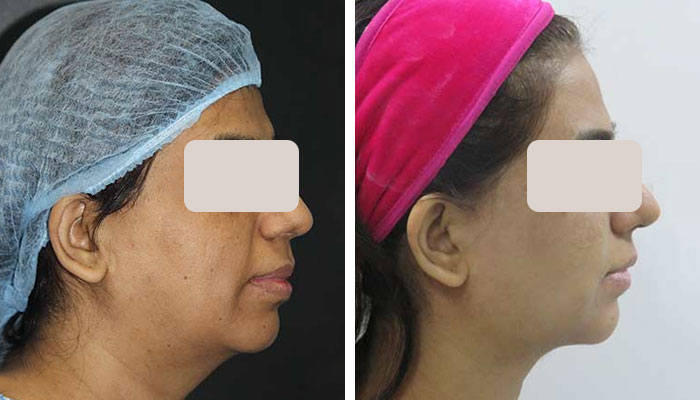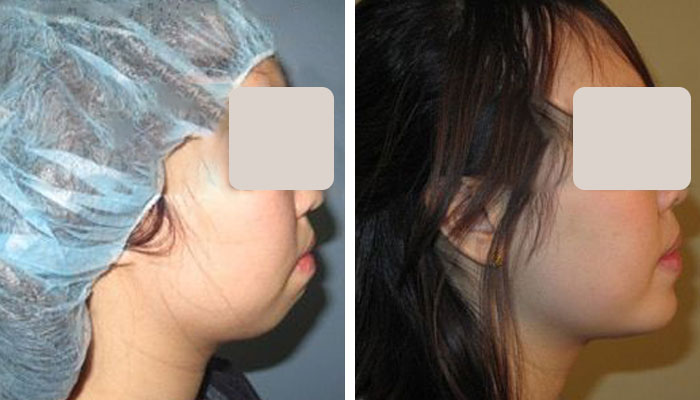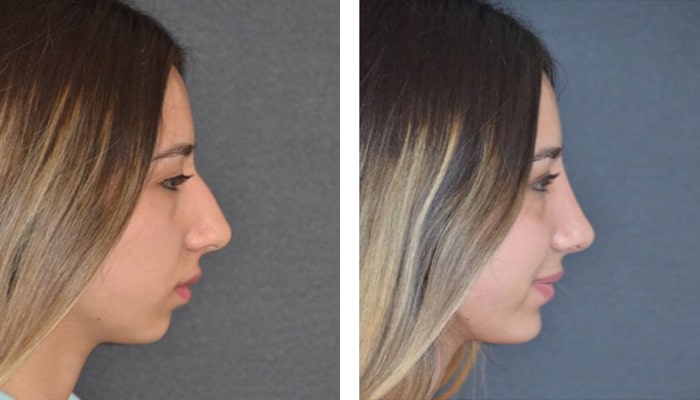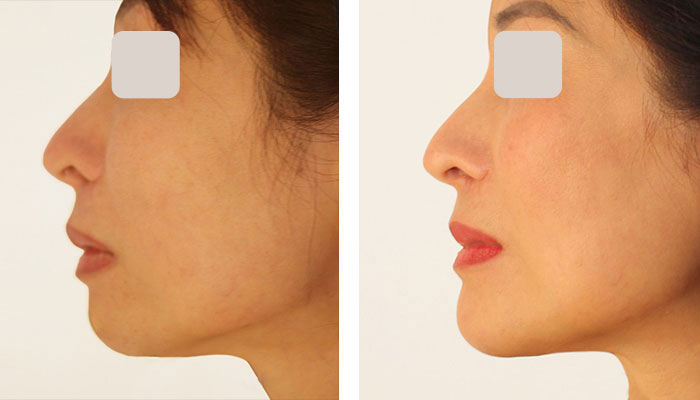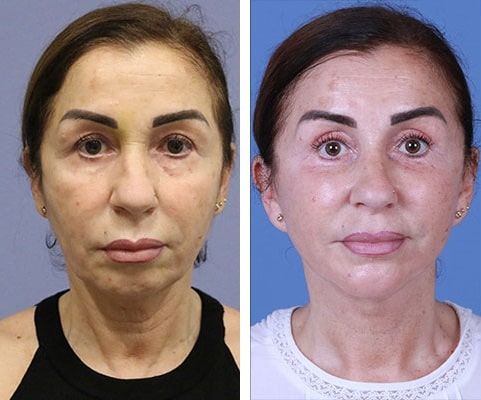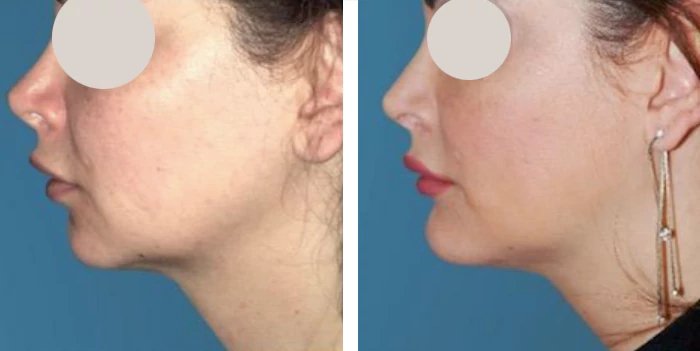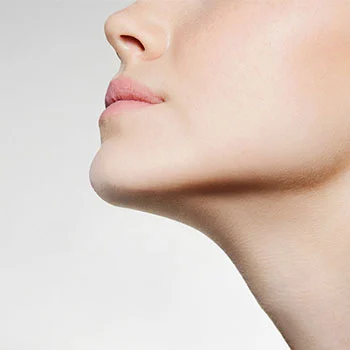What is a chin implant?
A chin implant, also known as chin augmentation, mentoplasty, or genioplasty, is a surgical procedure in which a solid, biocompatible implant is placed on the chin bone to enhance its shape, projection, and definition. The implant is typically made of silicone or other materials that are compatible with the body. Chin implants can be customized in terms of size, shape, and contour to achieve the desired aesthetic outcome. This procedure helps improve the balance and harmony of facial features, particularly the profile and jawline. It is typically performed under local or general anesthesia in an outpatient surgical setting.
Why are chin implants used?
Chin implants are used for various reasons to enhance the appearance of the chin and improve facial harmony. Here are some common reasons why chin implants are used:
- Chin augmentation: Chin implants are primarily used to augment a weak or recessed chin. By adding volume and projection to the chin, the implant can create a more balanced and proportionate facial profile.
- Facial balance: A well-defined chin can contribute to overall facial balance and harmony. Chin implants can help bring the chin into better alignment with other facial features, such as the nose or lips.
- Jawline definition: Chin implants can also enhance the definition and contour of the jawline. By providing additional projection to the chin, they can create a more defined and sculpted jawline.
- Correcting facial asymmetry: Chin implants can be used to address facial asymmetry caused by a naturally uneven or misaligned chin. By adding volume to one side of the chin, the implant can help create a more symmetrical appearance.
- Reconstructive purposes: In some cases, chin implants may be used for reconstructive purposes, such as correcting congenital chin deformities, traumatic injuries, or defects resulting from previous surgeries.
Chin implants are a surgical option for individuals who desire long-lasting results and more significant changes to their chin and jawline. It's important to consult with a qualified plastic surgeon who can evaluate your specific needs, discuss the potential benefits and risks, and guide you toward the most appropriate treatment plan.
Who is a chin implant suitable for?
A chin implant is suitable for individuals who desire to improve the balance and proportion of their facial features, particularly those with:
- Receding or weak chin: A chin implant can augment a weak or recessed chin, helping to create a more defined and balanced facial profile.
- Lack of chin projection: Some individuals may have a chin that lacks projection, making the neck and jawline appear less defined. A chin implant can provide the desired projection, enhancing facial harmony.
- Facial asymmetry: If there is significant asymmetry in the chin area, a chin implant can help achieve better symmetry and improve overall facial aesthetics.
- Aging effects: As we age, the chin may lose volume and definition, contributing to a less youthful appearance. A chin implant can restore chin contour, providing a rejuvenated look.
While chin implants can be beneficial for many individuals seeking facial enhancement, there are certain situations where a person may not be a good candidate for this procedure. Some factors that may make someone unsuitable for a chin implant include:
- Insufficient bone structure
- Significant dental or orthodontic issues
- Unrealistic expectations
- Certain medical conditions such as bleeding disorders or active infections
- Mental health concerns
It's important to consult with a qualified plastic surgeon who can assess your specific facial anatomy, discuss your goals, and determine if a chin implant is suitable for you. They will consider factors such as bone structure, skin elasticity, and overall facial harmony to help you make an informed decision.
How is a chin implant procedure performed?
The chin implant procedure is typically performed in an outpatient surgical setting and involves the following steps:
- Anesthesia: The procedure can be performed under local anesthesia with sedation or general anesthesia, depending on the patient's preference and the surgeon's recommendation. This ensures that the patient is comfortable and pain-free during the procedure.
- Incision placement: The surgeon will make an incision either inside the mouth (intraoral approach) along the lower gum line or externally under the chin (submental approach). The choice of incision placement depends on factors such as the type of implant, desired outcome, and surgeon's preference.
- Implant placement: The surgeon creates a pocket in front of the chin bone to accommodate the implant. The implant, typically made of silicone or other biocompatible materials, is carefully selected based on the desired size and shape. The implant is then inserted and positioned securely within the pocket.
- Incision closure: The incision is closed using sutures that may dissolve on their own or need to be removed at a later date, depending on the type of sutures used. If an intraoral incision is made, the sutures are usually placed on the inside of the mouth, making them less visible.
- Recovery and post-operative care: After the procedure, the patient is monitored in a recovery area to ensure their stability. The surgeon will provide instructions on post-operative care, including pain management, oral hygiene, dietary restrictions, and activity limitations. Swelling and bruising are common after the procedure but should subside over time.
It's important to note that specific details of the chin implant procedure may vary depending on the patient's individual needs, the surgeon's technique, and the type of implant used. It's crucial to consult with a board-certified plastic surgeon who can provide a thorough evaluation, discuss the procedure in detail, and address any questions or concerns you may have.
How to prepare for the procedure?
To prepare for a chin implant procedure, it is important to follow the pre-operative instructions provided by your surgeon. Here are some general guidelines:
- Consultation and medical evaluation: Schedule a consultation with a qualified plastic surgeon to discuss your goals, expectations, and medical history. The surgeon will evaluate your chin and overall facial structure to determine if you are a suitable candidate for the procedure.
- Medical clearance: If required, obtain medical clearance from your primary care physician or any specialists involved in your healthcare. This is particularly important if you have any underlying medical conditions or are taking medications that may affect the surgery or anesthesia.
- Quit smoking and avoid blood thinners: If you smoke, it is advised to quit smoking several weeks before the procedure, as smoking can impair healing and increase the risk of complications. Additionally, avoid medications and supplements that can thin the blood, such as aspirin, nonsteroidal anti-inflammatory drugs (NSAIDs), and herbal supplements, as they can increase the risk of bleeding.
- Medication review: Provide a comprehensive list of all medications, supplements, and herbal remedies you are currently taking to your surgeon. They will advise you on which medications to continue or discontinue before the procedure.
- Fasting: Follow the fasting guidelines provided by your surgeon. Typically, you will be instructed to avoid eating or drinking anything (including water) for a certain period of time before the procedure to ensure an empty stomach.
- Arrange transportation: As the procedure may involve sedation or general anesthesia, arrange for someone to drive you home after the surgery. It is not safe to drive yourself or use public transportation immediately after the procedure.
- Post-operative arrangements: Make necessary arrangements for your recovery, such as having someone to assist you at home, taking time off work, and ensuring you have any prescribed medications and supplies ready.
Follow pre-procedure instructions: Your surgeon will provide specific instructions tailored to your situation. These may include avoiding certain skincare products, showers or baths the night before, and wearing comfortable clothing on the day of the procedure.
It is essential to communicate openly with your surgeon, follow their instructions, and ask any questions you may have. By adequately preparing for the procedure, you can help ensure a smoother and more successful experience.
What’s the recovery and aftercare like?
The recovery and aftercare following a chin implant procedure may vary from person to person, but here are some general guidelines:
- Immediate post-operative period: After the procedure, you will be monitored in a recovery area until you are stable. You may experience some swelling, bruising, discomfort, and tightness around the chin and jaw area. Your surgeon may prescribe pain medication to manage any discomfort.
- Dressings and bandages: Your surgeon may place a dressing or compression bandage around the chin and jaw area to minimize swelling and provide support. Follow your surgeon's instructions on how to care for the dressing and when it should be removed.
- Swelling and bruising: Swelling and bruising are common after a chin implant procedure and may last for several weeks. Applying cold compresses to the area as advised by your surgeon can help reduce swelling. Sleeping with your head elevated can also help minimize swelling.
- Oral hygiene: It is important to maintain good oral hygiene after the procedure. Your surgeon may provide specific instructions on how to clean your mouth and teeth, including any special mouthwash or oral care products to use.
- Diet and activity: Follow your surgeon's instructions regarding dietary restrictions. Initially, you may be advised to stick to a soft diet to avoid putting excessive pressure on the chin area. Avoid strenuous activities, heavy lifting, and vigorous exercise for a few weeks to allow for proper healing.
- Follow-up appointments: Your surgeon will schedule follow-up appointments to monitor your healing progress. Attend these appointments as scheduled and communicate any concerns or questions you may have.
- Long-term care: It is important to protect your chin implant by avoiding trauma or injury to the area. Be cautious when participating in activities that may put your chin at risk, such as contact sports. Follow your surgeon's instructions for long-term care and any recommended check-ups.
It's important to note that the recovery process can vary, and individual experiences may differ. It's crucial to closely follow your surgeon's post-operative instructions and reach out to them if you have any concerns or questions during the recovery period.
How much does a chin implant procedure cost?
The cost of a chin implant procedure can vary depending on several factors, including the geographic location, the surgeon's experience and reputation, the complexity of the procedure, the type of implant used, and any additional fees associated with the surgical facility or anesthesia.
Generally, the cost of a chin implant procedure in the United States ranges from $3,000 to $8,000 or more. It's important to note that this is an estimate, and the actual cost can vary significantly. Consulting with a qualified plastic surgeon will provide a more accurate assessment of the costs involved in your specific case.
Additionally, insurance typically does not cover the cost of chin implants when performed for cosmetic purposes, as it is considered an elective procedure. However, if the chin implant procedure is performed for reconstructive purposes or to correct a congenital defect, insurance coverage may be available. It is recommended to consult with your surgeon and insurance provider to understand the coverage options and potential out-of-pocket expenses.
What are the potential risks and complications of chin implants?
Like any surgical procedure, chin implant surgery carries potential risks and complications. While these are relatively rare, it's important to be aware of them. Here are some potential risks and complications associated with chin implants:
- Infection: There is a risk of infection at the surgical site. Following proper post-operative care instructions and taking prescribed antibiotics can help minimize this risk.
- Hematoma: A hematoma is a collection of blood that may occur under the skin. It can cause swelling and pain and require drainage.
- Implant shifting: In some cases, the implant may shift or move from its original position, requiring revision surgery to correct the placement.
- Implant extrusion: In rare cases, the implant may become exposed or extrude through the skin. This may require removal or replacement of the implant.
- Nerve damage: There is a possibility of temporary or, in rare cases, permanent damage to the nerves in the chin area. This can result in altered sensation or numbness.
- Scarring: The incisions made during the procedure may result in visible scars. However, the incisions are typically placed in inconspicuous locations to minimize their visibility.
Unsatisfactory aesthetic outcome: While rare, there is a possibility that the final aesthetic outcome may not meet the patient's expectations. It's important to have realistic expectations and communicate clearly with your surgeon about your desired results.
What are other alternatives to a chin implant?
While a chin implant is a popular option for enhancing the chin and jawline, there are alternative treatments available to achieve similar results. Some alternatives to a chin implant include:
- Dermal fillers: Injectable dermal fillers, such as hyaluronic acid-based fillers, can be used to augment the chin non-surgically. The filler is injected strategically to add volume and improve the projection of the chin. This option provides temporary results, typically lasting several months to a year, and may require periodic touch-ups.
- Fat transfer: Fat transfer, also known as fat grafting, involves removing fat from one part of the body (typically through liposuction) and injecting it into the chin area to enhance volume and projection. This technique uses the patient's own fat cells, making it a natural and potentially longer-lasting option than dermal fillers.
- Orthognathic surgery: Orthognathic surgery, also known as corrective jaw surgery, is a surgical procedure that involves repositioning the bones of the jaw to correct functional or structural issues. In some cases, this surgery can also improve the projection and appearance of the chin.
- Genioplasty: Genioplasty is a surgical procedure that involves reshaping the chin bone to enhance its projection or correct deformities. Unlike a chin implant, genioplasty involves modifying the patient's existing bone structure rather than using an implant. This procedure is more invasive and may have a longer recovery time compared to a chin implant.
It's important to consult with a qualified plastic surgeon or dermatologist to determine the most suitable alternative to a chin implant based on your specific goals, anatomy, and preferences. They will be able to assess your situation and recommend the most appropriate treatment option for you.
Chin implant vs. chin filler: pros and cons
Chin implants and chin fillers are both options for enhancing the appearance of the chin, but they differ in terms of their approach, longevity, and invasiveness. Here are some pros and cons of each:
Chin implant
Pros:
- Permanent results: Chin implants provide a long-lasting solution, as they are made of solid materials designed for durability.
- Customizable: Implants come in various shapes and sizes, allowing for customization to achieve the desired chin projection and contour.
- Surgical precision: The placement of a chin implant is a surgical procedure, allowing for precise control over the outcome.
- More dramatic results: Implants can provide a more significant change in chin projection and contour compared to fillers.
Cons:
- Surgical procedure: Chin implant surgery requires anesthesia, incisions, and a recovery period. It carries the typical risks associated with surgery.
- Irreversibility: As chin implants are permanent, removing or revising them may require additional surgery.
- Longer recovery: Recovery from chin implant surgery can take several weeks, including swelling and potential discomfort.
- Higher cost: Chin implant surgery is typically more expensive than non-surgical options like fillers.
Chin filler
Pros:
- Non-surgical: Chin fillers are non-invasive and involve injectable treatments, often with minimal to no downtime.
- Reversible: Fillers provide the flexibility to modify or reverse the results if desired, as the effects are not permanent.
- Quick procedure: Filler injections are typically quick, performed in an office setting, and do not require extensive recovery time.
- Lower cost: Chin fillers are generally more affordable compared to surgical options.
Cons:
- Temporary results: The effects of fillers are temporary, typically lasting several months up to a year. Maintenance treatments are necessary to sustain the results.
- Limited projection: Fillers have limitations in terms of how much projection they can provide compared to a chin implant.
- Repeat treatments: To maintain the desired results, repeat injections are necessary, which may increase long-term costs.
- Not suitable for all concerns: Fillers may not be appropriate for individuals with significant chin deformities or those seeking more dramatic changes in chin projection.
Ultimately, the choice between a chin implant and chin filler depends on individual goals, anatomy, preferences, and the advice of a qualified medical professional. Consulting with a board-certified plastic surgeon or dermatologist can help determine the most suitable option for achieving the desired chin enhancement.
FAQs
Can I choose the size and shape of chin implants?
Yes, chin implants come in various sizes and shapes, allowing for customization based on individual preferences and desired chin projection.
When can I see the full results of my chin implant?
It may take several weeks to months for the swelling to fully subside and for the final results of a chin implant to become apparent.
Is a chin implant permanent?
Chin implants are designed to be permanent, providing long-lasting results. However, they can be removed or revised if desired, although this would require an additional surgical procedure.
Does a chin implant surgery leave scars?
Chin implant surgery typically involves making a small incision either inside the mouth (intraoral) or under the chin (submental). Intraoral incisions leave scars inside the mouth, while submental incisions leave scars that are usually well-hidden under the chin. Skilled surgeons aim to minimize scarring and ensure that they are discreet and inconspicuous.
Are chin implants different from jaw implants?
Yes, chin implants and jaw implants are different in terms of their purpose and placement. Chin implants are specifically designed to enhance the projection and shape of the chin, improving facial balance and profile. They are placed on the front part of the chin bone.
On the other hand, jaw implants are used to augment the width and contour of the jawline. They are placed along the jawbone to provide a more defined and angular jaw appearance. Jaw implants can help create a stronger and more masculine or feminine facial structure, depending on the desired outcome. Both chin and jaw implants can be used together to achieve a harmonious overall result, but they serve distinct purposes and are placed in different areas of the face.


